How to Help Humanity Help Itself – One Community Weekly Progress Update #402
How to help humanity help itself: DIY open source sustainability resources that provide a better living experience while also supporting global regeneration and addressing global challenges with food, energy, housing, education, etc. We can create a better world for everyone if we work together as a grassroots movement of people improving their own lives and the lives of others through sustainable living practices.
- Here’s our project overview
- Here’s our world-change methodology
- Here’s how this becomes self-replicating
- Here’s how we are open source and free-sharing all the do-it-yourself designs
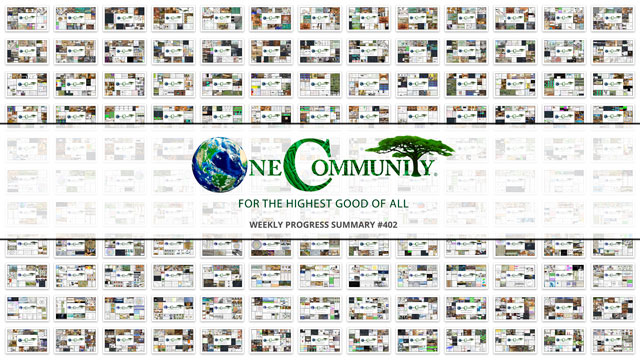
OUR MAIN OPEN SOURCE HUBS
Click on each icon to be taken to the corresponding Highest Good hub page.
One Community’s physical location will forward this movement as the first of many self-replicating teacher/demonstration communities, villages, and cities to be built around the world. This is the December 6th, 2020 edition (#402) of our weekly progress update detailing our team’s development and accomplishments towards the mission of how to help humanity help itself:
How to Help Humanity Help Itself
One Community Progress Update #402
DONATE | COLLABORATE | HELP WITH LARGE-SCALE FUNDING
CLICK HERE IF YOU’D LIKE TO RECEIVE AN EMAIL EACH WEEK WHEN WE RELEASE A NEW UPDATE
YOU CAN ALSO JOIN US THROUGH SOCIAL MEDIA
ONE COMMUNITY WEEKLY UPDATE DETAILS
HIGHEST GOOD HOUSING PROGRESS
 One Community is demonstrating how to help humanity help itself through Highest Good housing that is artistic and beautiful, more affordable, more space efficient, lasts longer, DIY buildable, and constructed with healthy and sustainable materials:
One Community is demonstrating how to help humanity help itself through Highest Good housing that is artistic and beautiful, more affordable, more space efficient, lasts longer, DIY buildable, and constructed with healthy and sustainable materials:
-
-
- Learn about: Our Upcoming Crowdfunding Campaign
- Learn about the different village models: 7 Sustainable Village Models
- Visit the open source portals for the first two: Earthbag Village OS Hub | Straw Bale Village OS Hub
-
This week the core team updated the Best Small and Large-scale Recycling, Reuse, and Repurposing Options page, added all the recycling icons to the Highest Good of All page, and also to each of the different recycling pages. Thus, contributing efforts to the mission of how to help humanity help itself.

Updated the Best Small and Large-scale Recycling, Reuse, and Repurposing Options Page – Click to Visit
The core team also generated the “Night stands” and “table/benches – down position” renders below for the Murphy bed assembly instructions and reflecting the latest updates.

Generated the Murphy Bed “Night Stands” and “Table/benches – Down Position” Renders – Click for Furniture Page
Dean Scholz (Architectural Designer) continued helping with the Earthbag Village (Pod 1) 4-dome cluster designs. This week was week #204 of Dean’s work and the focus was more plant corrections, lighting and quality corrections, and completing the two side views here that are final renders. The top-down render still needs some plant corrections.
Alvaro Hernández (Open Source Tech Consultant, Developer) completed his 34th week as a member of the team and continued working on the Best Small and Large-scale Community Plastic Recycling, Repurposing, and Reuse Options tutorial. This week Alvaro worked on the “REUSING PLASTIC” section of the plastics article. He found conflicting information related to the refilling of plastic bottles during his research and will dig deeper into this to get better information sources and identify which one is correct. He also studied One Community’s phased rollout to identify when and how plastic waste management should be implemented. Pictures below show some of this work towards the mission of how to help humanity help itself.
This week Jose Luis Flores (Mechanical Engineer) completed his 20th week helping finish the Net-zero Bathroom component of the Earthbag Village. This week Jose Luis updated the support material used in the Net-Zero Bathroom to list nails instead of rebar. He updated the spreadsheet used to calculate the number of earthbags needed to construct the structure. The updated calculations were used to calculate the number of nails needed to mesh and secure the earthbags vertically. The calculations only took into account stacked earthbags that were contacting each other. The quantity of nails was then added to the cost analysis spreadsheet, along with a vendor and price.
He continued adding more details and diagrams to the “Roof Panel Installation” section of the Net-Zero Bathroom tutorial draft. The additions included roof paper installation instructions to simplify installation, reduce waste, and maximize sealing for both the exterior and interior roof. A diagram illustrating where to apply butyl tape was added and various images were included to simplify the instructions. The pictures below show examples of some of this work towards the mission of how to help humanity help itself.
Hannah Copeman (Structural Engineer) completed her 16th week helping complete all the Earthbag Village tutorials. This week Hannah continued the development of the Earthbag Village dome construction by working on the structural design of the loft. She finalized the updated design, edited the relevant spreadsheets to be user friendly by identifying inputs, and creating drawings to be used for SketchUp replication. You can see some screenshots of this work below towards the mission of how to help humanity help itself.
Alvin Anggito (BS Civil Engineering) completed his 2nd week working on the Communal Eco-shower footer, foundation and flooring engineering. This week Alvin continued on the communal eco-shower designs. He added the shower heads and sinks to the design and also labeled the parts of the communal eco-shower. Alvin also started to look into the cost analysis for the communal eco-shower. The pictures below show examples of some of this work towards the mission of how to help humanity help itself.
DUPLICABLE CITY CENTER PROGRESS
 One Community is demonstrating how to help humanity help itself through a Duplicable and Sustainable City Center that is LEED Platinum certified/Sustainable, can feed 200 people at a time, provide laundry for over 300 people, is beautiful, spacious, and saves resources, money, and space:
One Community is demonstrating how to help humanity help itself through a Duplicable and Sustainable City Center that is LEED Platinum certified/Sustainable, can feed 200 people at a time, provide laundry for over 300 people, is beautiful, spacious, and saves resources, money, and space:
-
-
- Learn about this building and it’s function: Duplicable City Center Open Source Hub
-
This week Angela Mao (Sustainability Researcher) completed her 19th week as a member of the team and working on content for the Most Sustainable Lightbulbs and Light Bulb Companies and the Best Small and Large-scale Community Options for Sustainable Processing & Reuse of Non-recyclables tutorial. This week, Angela wrote about the effects of certain lightbulbs on the nervous system and added more information about each brand.
She additionally worked on her non-recyclables tutorial, having found 7 different solutions and compiling research on each of those. She also began to compare their cost, labor, and feasibility. Pictures below show some of this work-in-progress towards the mission of how to help humanity help itself.

Wrote About Effects of Certain Lightbulbs on the Nervous System and Worked on Non-recyclables Tutorial – Click for Lightbulbs Page
Ksenia Akimov (Plumbing Engineer) completed her 12th week working on the Duplicable City Center plumbing designs. This week Ksenia worked on creating pipe lines for cold hot and hot circulation water supply systems for the main floor Social and Living Dome bathrooms. Pictures below show some of this work towards the mission of how to help humanity help itself.
Lindy Rzonca (Sustainability Analyst) also completed her 9th week helping with sustainability research and now focused on the Best Small and Large-scale Community Options for Sustainable Processing and Reuse of Non-recyclables tutorial. This week, Lindy continued to read what the other researches had done, organize this information and began making her own edits. She also began more in-depth research on the wast-to-energy (WTE) methods, and reached out to some of the previously researched WTE companies. This week, she was still doing a lot of reading and digesting of information. Pictures below are related to this work towards the mission of how to help humanity help itself.

Continued Working on the Best Community Options for Sustainable Processing and Reuse of Non-recyclables Tutorial – Click for Page
Qiuheng Xu (Landscape Designer) completed her 9th week helping with the Duplicable City Center updated video walkthrough. This week Qiuheng finished all but two corrections for the City Center walkthrough, making modifications in both the SketchUp file and Lumion file. You can see the latest updated areas below.
Keerthi Gopalakrishnan (Product Ideation Analyst) completed her 4th week helping with the sustainability benchmarking of various hardware companies. This week she finished the write ups for Benchmarking and ranking all the Toilet, Urinal, Shower Head and Hand Dryer manufacturers and submitted them for review. Some pictures of this work-in-progress are below towards the mission of how to help humanity help itself.

Finished the Write Ups for Benchmarking and Ranking Toilet, Urinal, Shower Head and Hand Dryer Manufacturers – Click for Hand Dryer Page
Md Amanullah Kabir (Mechanical Engineer) also joined the team and completed his first week working on the Duplicable City Center rainwater harvesting component. This week Md focused on gathering information about the ground gutter system. In our footprint roof slopes are in all directions. Because of that, a ground gutter system is required to protect the foundation of the structure, prevent erosion, protect landscaping, and prevent basement flooding. Material selection of the piping for this is one of the most important factors. Md researched the different types of materials that are available: Seamless Aluminum, Copper, Steel, Vinyl, Polypropylene, Zinc, etc.
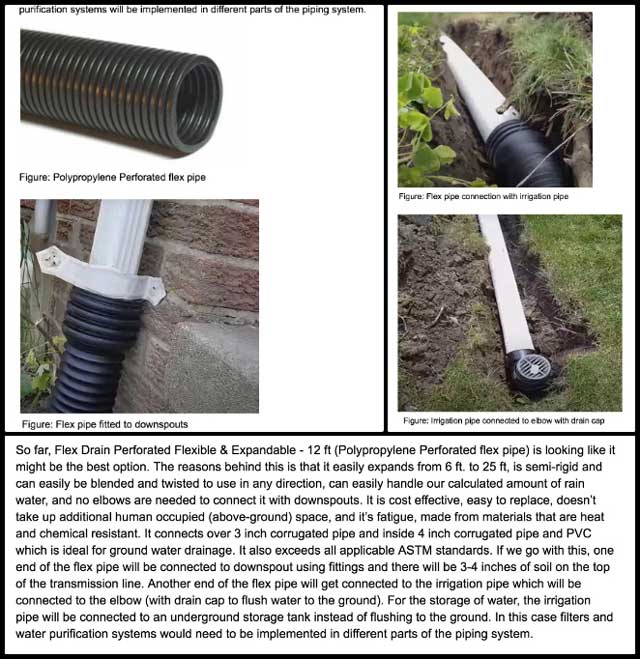
Joined the Team and Began Working on the Duplicable City Center Rainwater Harvesting Component – Click for Page
HIGHEST GOOD FOOD PROGRESS
 One Community is demonstrating how to help humanity help itself through Highest Good food that is more diverse, more nutritious, locally grown and sustainable, and part of our open source botanical garden model to support and share bio-diversity:
One Community is demonstrating how to help humanity help itself through Highest Good food that is more diverse, more nutritious, locally grown and sustainable, and part of our open source botanical garden model to support and share bio-diversity:
-
-
- Learn about the structures: Hoop House Hub | Aquapini & Walipini Open Source Hub
- See what we’ll be growing: Gardens & Hoop Houses | Large-scale Structures | Food Forest | TA
-
This week the core team continued with our new plan for the Transition Kitchen. We rearranged placement of the tables to create efficient traffic flow patterns around tables positioned more along the centerline of the building. You can see the arrows on the floor tiles that show the first traffic movement layout and then an updated one on the right that will allow for two lines of people to serve themselves at once and then people with their food to access the seating without crossing the line of people waiting to serve themselves.
The core team also continued rewriting/finalizing the chicken coop doc step-by-step instructions. This week we continued our review through page 15 of the chicken coop doc and engaged in discussions and collectively finalizing a solution for addressing the sequential construction features in the coop doc due to our lack of the necessary experience and team resources to make this less-important component of the project as good as it can be.
We resolved this issue by noting the areas in question and reserving those corrections for when we are on site and will be able to build the structure with more people and more experienced people to work out the remaining improvements together as we construct the first coop. Pictures below show some of this behind-the-scenes work-in-progress towards the mission of how to help humanity help itself.
The core team created a bunch of updated measurement imagery too.
Jiayu Liang (Landscape Designer) completed her 10th week helping with the Aquapini & Walipini internal and external landscaping details. This week Jiayu finished all the models, and began doing the renderings in lumion. Some pictures of this work-in-progress are below towards the mission of how to help humanity help itself.
Jingwei Jiang (Landscape Designer) also completed her 10th week working on the landscaping specifics of the Earthbag Village. This week, Jingwei Jiang developed more in the center. The layers added include fruit trees, shrubs, and edge plants. The trees will be ornamental and produce some food. Initial selections from SketchUp 3D models match with the planting list. The plants though in the SketchUp model are not the exact plants in the planting list. The shrubs can be selected in the shrub category, while edge plants can be selected from the edge plants category. Pictures of this work-in-progress are below towards the mission of how to help humanity help itself.
Henry Vennard (Mechanical Engineer) also completed his 9th week helping continue the development of the climate batteries for the Aquapini/Walipini structures. This week Henry took on calculating an accurate measure for the air inside the greenhouse given no heating. This calculation will be useful in determining the effectiveness of the climate battery and determining what kind of external heater will be needed for backup. You can see some pictures related to this work below towards the mission of how to help humanity help itself.
HIGHEST GOOD EDUCATION PROGRESS
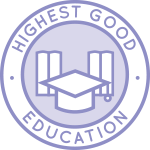 One Community is demonstrating how to help humanity help itself through Highest Good education that is for all ages, applicable in any environment, adaptable to individual needs, far exceeds traditional education standards, and more fun for both the teachers and the students. This component of One Community is about 95% complete with only the Open Source School Licensing and Ultimate Classroom construction and assembly details remaining to be finished. We’ll report on the final two elements to be finished as we develop them.
One Community is demonstrating how to help humanity help itself through Highest Good education that is for all ages, applicable in any environment, adaptable to individual needs, far exceeds traditional education standards, and more fun for both the teachers and the students. This component of One Community is about 95% complete with only the Open Source School Licensing and Ultimate Classroom construction and assembly details remaining to be finished. We’ll report on the final two elements to be finished as we develop them.
With over 8 years of work invested in the process, the sections below are all complete until we move onto the property and continue the development and open sourcing process with teachers and students – a development process that is built directly into the structure of the education program and everything else we’re creating too:
- Program Overview: Education Open Source Hub
- How the components work together: How to use the Education for Life Program
- Lesson Plans for Life – Lesson Plans How-to
- Foundations of Outstanding Leaders, Teachers, and Communicators
- Curriculum for Life
- Teaching Strategies for Life
- Learning Tools and Toys for Life
- Evaluation and Evolution

Highest Good Education: All Subjects | All Learning Levels | Any Age – Click image for the open source hub
HIGHEST GOOD SOCIETY PROGRESS
 One Community is demonstrating how to help humanity help itself through a Highest Good society approach to living that is founded on fulfilled living, the study of meeting human needs, Community, and making a difference in the world:
One Community is demonstrating how to help humanity help itself through a Highest Good society approach to living that is founded on fulfilled living, the study of meeting human needs, Community, and making a difference in the world:
-
-
- Read the Highest Good society overview: Highest Good Society
- Learn about the model for fulfilled living and sharing: A Day in the Life
- Learn about the 4 economic models: RBE | For-profit | Non-profit | Entrepreneurship
- Learn about our open source community collaboration and management software: The Highest Good Network
-
This week the core team completed 19 hours managing One Community emails, social media accounts, interviewing potential new volunteer team members, and managing volunteer-work review and collaboration not mentioned elsewhere here.
The core team also continued working on the large-scale consensus content. This week we finished transferring the written content to the webeditor development page for the huge Consensus with Large Groups update we’ve been working on. You can see some pictures of this behind-the-scenes work below towards the mission of how to help humanity help itself.
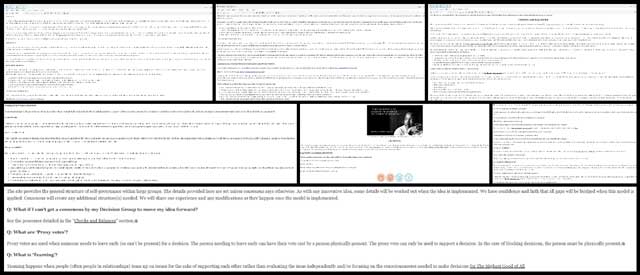
Finished Transferring the Written Content to the Webeditor Development Page – Click for Consensus Page
Wen Zhang (Software Engineer) completed her 27th week as a volunteer working on the Highest Good Network software. This week Wen fixed a bug she found when trying to optimize the implementation of the badge controller – combining with the user profile to save some data. But when she populated the badge model from the user profile, she got an empty object on Postman – no data returned. She thought it was something related to nested paths, so she read the original mongoose doc to see a few examples showing nested paths.
No, actually that was not the problem, the issue was all about the badge model reference. She also created 2 Pull Requests for our December 1st MVP, one for the front end repo and another one for the back end repo. Pictures of some of this work are below towards the mission of how to help humanity help itself.

Fixed a Bug She Found When Trying to Optimize the Implementation of the Badge Controller – Highest Good Network
TEKtalent Inc. (a custom programming solutions company) also continued with their 26th week helping with the Highest Good Network software. This week Nithesh and the TEK Talent team focused on working on the code review comments and Azure migration troubleshooting. The issue on login was resolved and we’re now able to login to the dev portal which is hosted in Azure. Thus, contributing towards the mission of how to help humanity help itself.
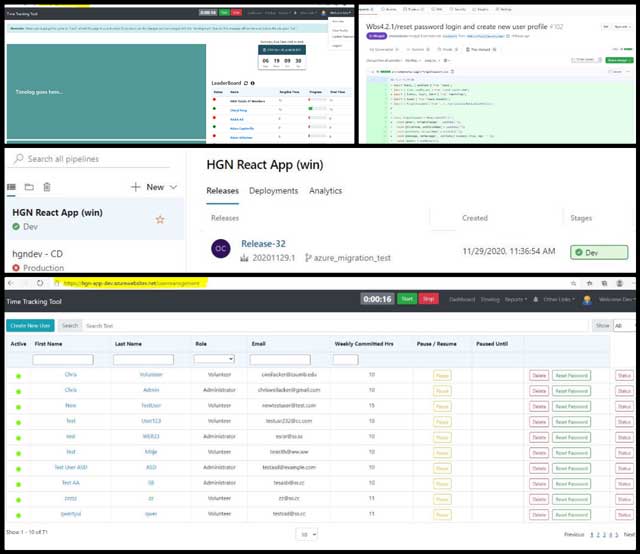
Focused on Working on the Code Review Comments and Azure Migration Troubleshooting – Click for Highest Good Network
Yiqi Feng (Software Engineer) continued with her 19th week as a member of the Highest Good Network software team. This week Yiqi updated the username and four badge patterns. She added a “Current week” bar to show working hour status. She also implemented the functionality needed so that clicking the first three badges will take users to the related sections. Finally, she CSS coded the check and “!” details, rather than having them as images. You can see some pictures related to this work below towards the mission of how to help humanity help itself.
Jerry Zhang (Software Engineer) completed his 14th week working on the Highest Good Network software. This week Jerry looked through the time entry component and decided we will incorporate TinyMCE and react-html-parser into our task notification component and the add/edit task modal. Small PR for task notifications now expire automatically after 1 month. He then started on task progress functionality of his team-member-tasks component. Beginning with backend model + routes. Pictures are below showing some of this work towards the mission of how to help humanity help itself.
Chris Weilacker (Software Engineer) completed his 14th week working on the Highest Good Network software. This week Chris got intangible time to be logged as required when entering a manual time log entry and when using the timer functionality from a mobile phone. He also changed the timelog component filter to allow for filtering multiple entries. Chris also reviewed several pull requests. Pictures related to this work are below towards the mission of how to help humanity help itself.
Noor Qureshi (Insurance Researcher) completed her 16th week helping research One Community’s insurance options. This week Noor worked more on the comparison of the different plans chosen. She compared the plans based off which ones had the ability to create a MPN and whether they were company/private or individual/family. She also began to breakdown the different coverages and what each plan provided for the associated benefit. She arranged them in a way with the plans with highest costs at the top and plans with the lowest costs at the bottom. You can see some pictures related to this work below towards the mission of how to help humanity help itself.
Jun Hao (Software Engineer) also completed his 13th and final week working on the Highest Good Network software. This week Jun was finished his part of working on the user profile component. He cleaned up the code by removing unnecessary code blocks and simplifying code logics in many subcomponents. He also finished most parts of the unit tests of the component. He wrapped up the code and pushed it to the development branch. You can see some of this work below towards the mission of how to help humanity help itself.
Jaime Arango (Graphic Designer) also completed his 12th week helping with various graphic design work for the project, continuing this week working on the new badges for the badges section on the Dashboard of the Highest Good Network. This week Jaime kept working on improving existing badges. This week he finished all the 30 hours streak badges and started the 40 hours streak ones. Pictures of the updated badges are below. Hence, contributing towards the mission of how to help humanity help itself.

Worked on New Badges for the Badges Section on the Dashboard of the Highest Good Network – Click for Page
AND WE PRODUCED THIS WEEKLY UPDATES BLOG – CLICK HERE TO SUBSCRIBE
FOLLOW ONE COMMUNITY’S PROGRESS (click icons for our pages)
INVESTOR PAGES
GET INVOLVED
DONATE ● WAYS ANYONE CAN HELP ● MEMBERSHIP
CLICK HERE FOR ALL PAST UPDATES
HOW TO HELP HUMANITY HELP ITSELF –
WHAT ONE COMMUNITY IS CREATING
One Community is creating a place to grow together and change the world together. We are creating a space that helps each other live in integrity with each other and the planet as we strive to be the greatest versions of ourselves. We do this by harmoniously respecting each other, nature, and the rest of our one shared planet.
Our goal is to demonstrate what we feel is the most sustainable, healthy, and fun environment we can create by teaching people how to help humanity help itself. A place based on compassion, kindness, and collaboration. This replicable community will serve as an example for what is possible.
Throughout our design process of how to help humanity help itself model we are open sourcing and free-sharing everything needed for construction and replication. This includes what we call “Highest Good” approaches to food, energy, housing, education, for-profit and non-profit economics design, social architecture, fulfilled living, stewardship practices and more. We are creating these resources for implementation as individual components or complete developments called teacher/demonstration hubs. These hubs will help launch additional hubs as awareness and knowledge grow. Thus, contributing to the mission of how to help humanity help itself.
HOW TO HELP HUMANITY HELP ITSELF – BUILDING THE FIRST OF MANY
One Community will be the first teacher/demonstration hub. It will function as an experiential-learning model that facilitates mass participation to address humanity’s most pressing challenges through: A replicable model for expansion, building seven self-sufficient village/city prototypes, becoming the world leader in open-source sustainability solutions, and evolving and expanding ALL aspects of sustainable living such as the mission of how to help humanity help itself.
HOW TO HELP HUMANITY HELP ITSELF – WHY ONE COMMUNITY IS CREATING THIS
The One Community self-replicating model for how to help humanity help itself is capable of creating a sustainable planet within 30 years. We will achieve this by establishing successful teacher/demonstration hubs on every continent. Villages include designs appropriate for each of the five main types of climates. They also include options for even the most challenged economies. These hubs will collaborate with one another, share ideas, resources, and work together as a network to heal the planet. They will also transform the global lifestyle to a more enjoyable, fulfilling, healthy, and sustainable one. Thus, contributing to the mission of how to help humanity help itself.
The specifics of how One Community is accomplishing this how to help humanity help itself model can be found on the One Community Solution Model to Create Solution-creating Models Page. Research supporting and showing the benefits of a model like this can be found on our Research and Resources Articles Archive.
Even if we don’t achieve our ultimate goal of global transformation, a self-replicating teacher/demonstration model like how to help humanity help itself will take a relatively short period of time to positively affect millions while inspiring millions more. For One Community residents (the Pioneer Team), the idea of creating and sharing the social and recreational experience with visitors is also fun, exciting, fulfilling, and an additional reason why we are creating this model of how to help humanity help itself.
 One Community
One Community


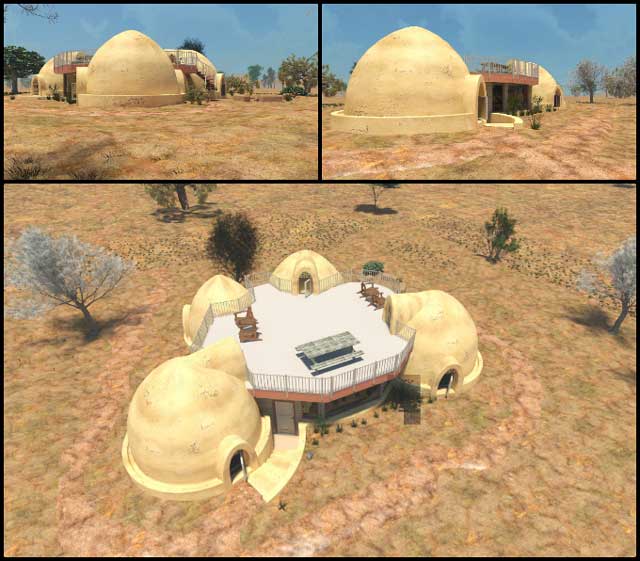



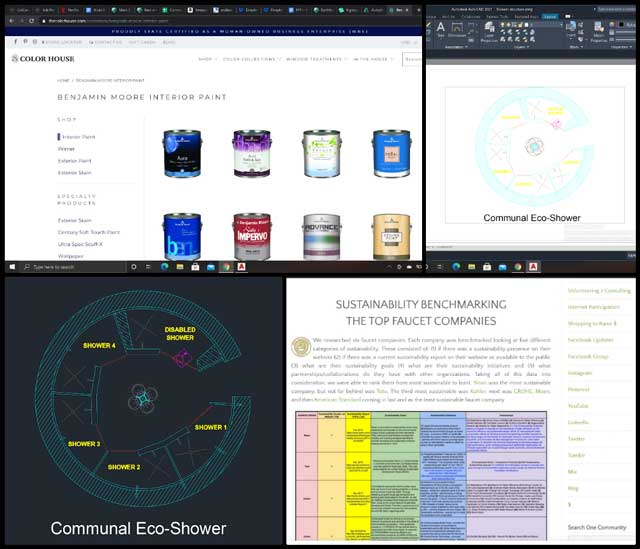

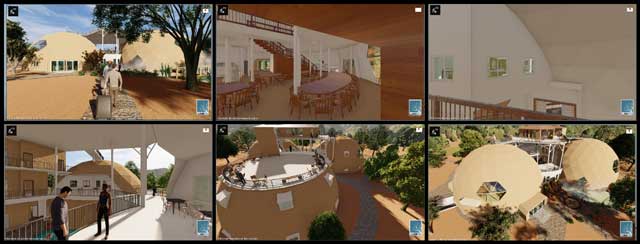





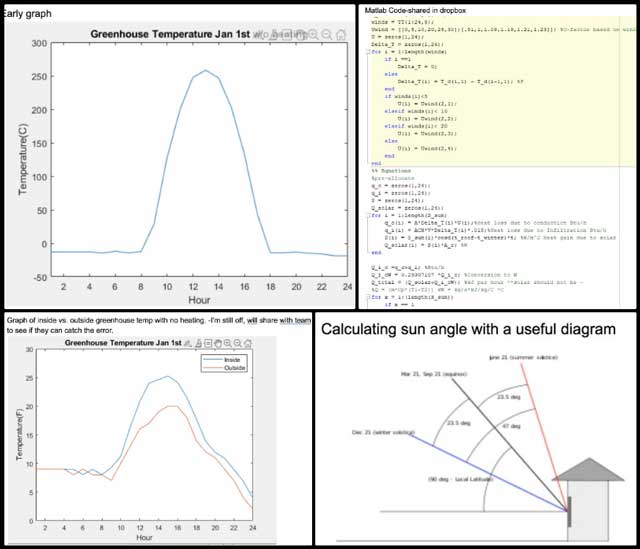





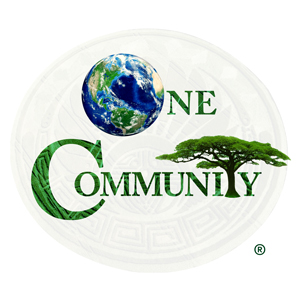


Connect with One Community